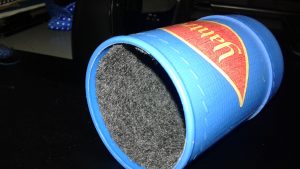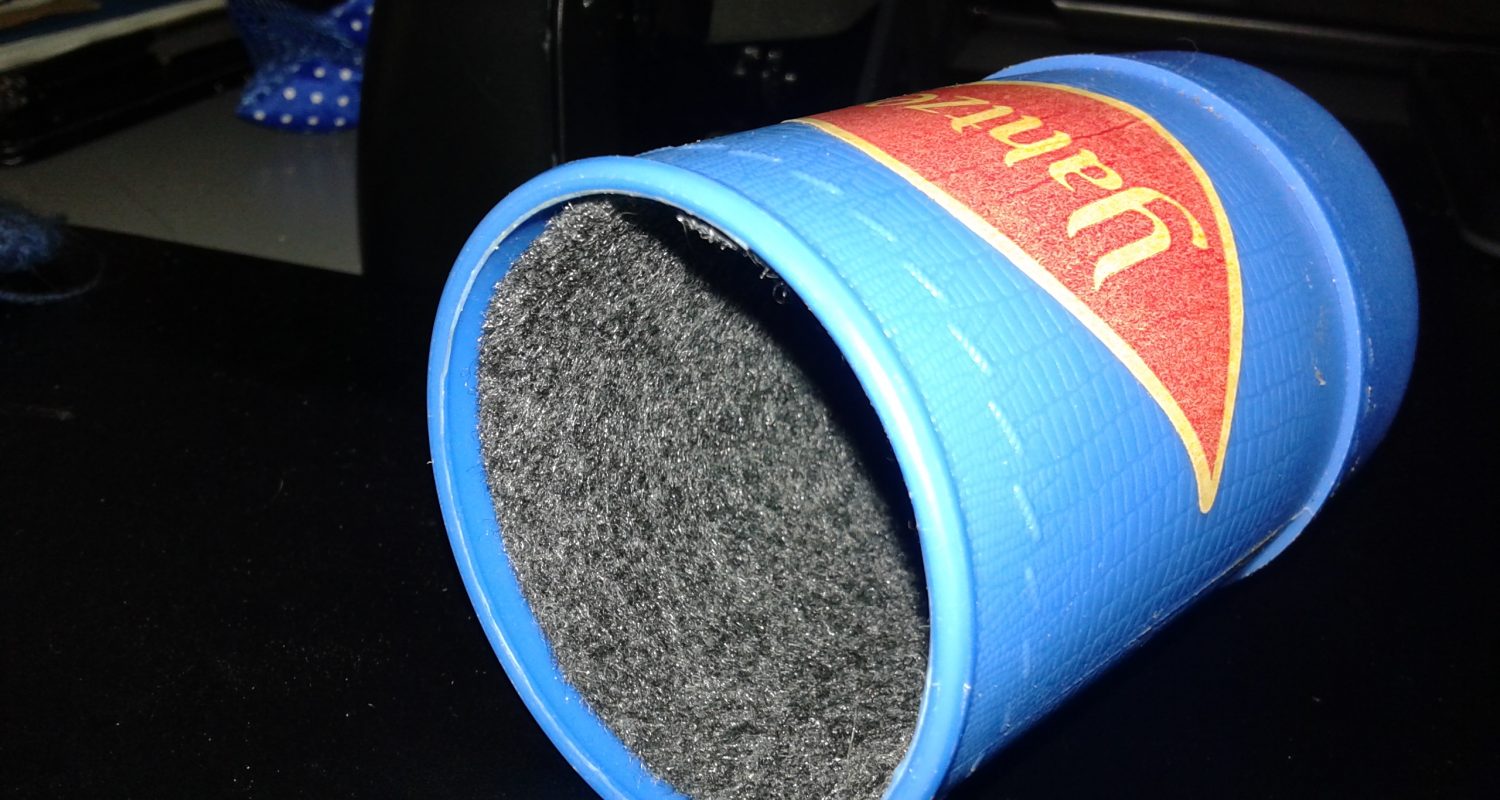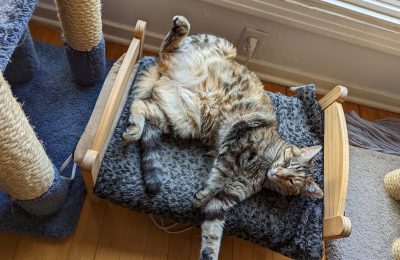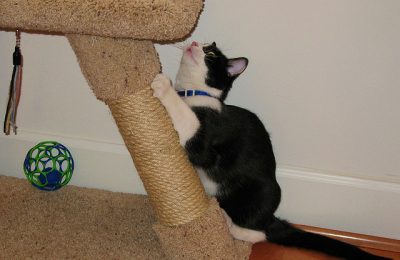
Well, perhaps I should start by explaining the Yahtzee Barf. Saturday night at our pad is pizza night (we make pizza), and sometimes we play games too. One night we were playing Yahtzee, with one of our cats sitting nearby (she likes to help). We couldn’t help but notice that every time we shook the dice in the Yahtzee cup, our cat started gagging. The behavior would stop as soon as we stopped shaking the dice in the cup, and then would start again with each turn. What the heck? We coined this behavior “Yahtzee Barf” and did what any reasonable person would do, we lined the Yahtzee cup with felt so it wouldn’t make a loud, rattling noise each time we shook the dice.
I kind of forgot about her problem (although we did always note that even those she’s not a scaredy cat, our cat also hates the sound of tin foil and pans rattling in the cupboard) until a bunch of videos of cats gagging at different sounds came under my radar. These sounds included candy wrappers, a comb, tape, and a wrench clicking. Since then I’ve heard from other people that their cats respond similarly to keys clinking, stirring coffee with a spoon, and various other weird sounds. Turns out this is all over the internet too!
Cat gagging at comb
Another cat gagging from a comb
Yet another cat gagging from a comb!
Cat gagging at crinkling of foil wrapper
And another
Have I convinced you that the “Yahtzee Barf” (or at least “comb barf”) is real?
(Now these videos often get coined as funny, although like many popular internet videos of cats, I usually see a stressed out cat and a lack of human understanding of cat behavior. Don’t worry, it’s never too late to learn).
As a cat behavior consultant, I’ve also had clients whose cats became aggressive after particular sounds, such as running water and coffee grinders. Why such a strong reaction to a sound that seems so “normal” to us?

Last week a new study was published, Audiogenic Reflex Seizures in Cats, that might shed some light on this situation! The authors found that many older cats experienced seizures when exposed to various (and multiple) loud noises, which included the crinkling of tin foil (85% of cats in the study!), paper bags (73% of cats), the clicking of computer keyboards (64% of cats), Velcro, lighting a gas stove, running water, and computer printers. This epilepsy syndrome has been coined Feline Audiogenic Reflex Seizures, or FARS. The study used a combination of surveys (96 owner reports), physical exams (85 of those cats), and CT scans or MRIs (16 cats). All cats were between 10 and 19 years of age, with around half being your average domestic short hair, and about a third being Birmans or Birman mixes.
All owners reported that producing the sound in question could reliably cause their cat to go into a seizure, and avoiding the sound was fairly effective to prevent seizures. Given the nature of some of these noises, you can imagine how difficult that might be!
It turns out that cats aren’t the only ones who experience seizures from particular sound triggers: similar effects have been found in mice, rats, hamsters, and perhaps even dogs. In one report, human seizures were induced by the voices of particular television announcers.
What does this have to do with the “Yahtzee Barf” and other cats who are gagging at weird sounds? I have so many questions (as usual)!
Why are the triggers so individual (both for seizures and gagging)? Is this sound-sensitivity and gagging in otherwise healthy cats related to FARS? Is this a predictor of future seizure disorders in our pet cats? Or is there an interaction between this sound sensitivity and an underlying tendency toward a seizure disorder in cats, such that only certain cats will go on to experience seizures? Or is this a completely different condition or symptom altogether?

Cats are predators, and their prey (mice and rats) use ultrasonic sounds to communicate. Cats may have sensitivity to high-pitched sounds because outside, it helps them hunt. Indoors, living with humans, it may lead to lots of irritation, gagging, or even worse! For fifty percent of the cats in the current study, the owners believed their cat was hearing impaired or completely deaf. Cats that appear deaf to us may still have some sensitivity to very high-pitched sounds, and this sound-sensitivity may also explain why some scaredy-cats are so scared – ears adapted for hunting outside may not be prepared to deal with coffee grinders, tin foil, or jingling keys!
Perhaps the authors of this study will take on the Yahtzee Barf as a future area of research. They are currently examining all those DNA samples to see if there is a genetic cause for FARS. If there are genetic markers, Yahtzee-Barfing cats could be tested for those genes too.
Reference , , , , and Audiogenic reflex seizures in cats. Journal of Feline Medicine and Surgery, 1098612X15582080, first published on April 27, 2015doi:10.1177/1098612X15582080




i have a cat that I have had for 16 years. All at once he started seizures. He has been to our regular vet, a neurologist, and a cardiologist. We have spent a huge amount money of which I don’t care about; however, after all the complicated expensive tests they have performed on him and all the specialists we have seen nobody has any kind of answer on why he is going through this or how to treat it. Every single Dr. tells us his tests show him very healthy and more like a 8 year old cat instead of a 16 year old cat. I decided to lock myself in the bedroom with my baby and observe. The only thing I have noticed is he starts shaking and losing control with the sound of paper rattling. Not loud sounds but a candy wrapper, tissue paper being scrunched, velcro. I started looking this up on the internet and long behold it seems to be a problem cats can have as they get older. If your baby starts these problems I haven’t found out what kind of treatment there is, but at least I see it is something that not many vets seem aware of. If is a very scary thing to see my pal going through this. Not only is it scary to me, but it terrifies him. He has no control of himself and I am afraid one of these days I will lose him.
Christy, I’m so sorry to hear about your kitty, that sounds so scary! However, it does sound like you might want to speak with your veterinarian about FARS, there are some treatments available, see here: http://icatcare.org/advice/cat-health/FARS
I have a Siamese mix kitty that is just over a year old who gags over running my finger over an elastic strip and rubbing Velcro (the front of the “male side with the back of the soft female side. She’s only a year so it can range in ages, although she IS Siamese mix. It is such a strange thing to witness, I’m super glad she isn’t a total anomaly.
Thanks for sharing your experience! It is a very strange thing to witness!
I have a Snow Bengal that gags at the sound of plastic water bottles being crushed.
Our Siamese cat started doing this as well and she’s only a year and a half. Now that I understand what this is, we’re very careful to not make these sounds around her. Best to be careful with your cat too Renee. After watching those videos, I wish people would be more sensitive to their pets. I would assume nobody would want someone scratching fingers nails on a chalk board all day for pure amusement.
Kenny, I agree! I wish people were more attentive to body language and signs of stress! Thank you for your comment.
I just saw videos like this in Facebook and I’m surprised there isn’t so much we know about cats and combs. This is really helpful, thank you!
I’ve just found this article which was really interesting to read. Our 7 year old boy cat does this when I peel open a roll of sellotape and we’ve just discovered today that dropping coins into a coin jar also results in the same effect. I’m worried now that this is distressing for him after reading your article, but I wonder, if it’s so distressing, why doesn’t he just walk away when he hears the noise? Instead he sits there through every time the noise happens!
I’ve looked all over online and finally found this! I thought my cat was a freak, every time a ping pong ball would bounce even once, he would let out a gag. I was so confused, but needless to say no more ping pong in the house.
I have a kitten who is only like 9 months. She gags at almost all the mentioned sounds. Mostly wrappers though. She also does it to bell! I gave away all her bell toys and crinkly ones once I noticed. I hope it doen’t get even worse when she is older!
Anyone who has a microphone with extended frequency response, say out to 30K hertz even though humans only hear to 20K under the best of circumstances when young and high frequency falloff is very common as we age. With the microphone and software installed on a PC called an audio spectrum analyzer. the frequency response of these various noises could be analyzed for ultrasonic content. Record the audio spectrum of the combs, ping pong ball, crushed plastic films etc and see if they all have appreciable ultrasonic energy that we can;t hear. If so, those noises are creating stress due to noise content in region of sound that us humans can’t hear at all.
I have a feral who moved into our basement for over a year before coming upstairs to become socialized to our other 3 cats and 3 humans. But for the first year various noises would create fear and he would exit the house for at least a day before returning. Computer noises, doorbells, telephone rings, microwave oven beeps, all could be a trigger for fight and flight response. But over time he has relaxed and no longer sees these random noises as a threat. I don’t think any of these beeps and rings have much ultrasonic energy but the noises that are triggering these cats gagging reflex may be very rich in ultrasonics.
Hi David!
Excellent idea! I actually have a bat detector microphone, it would be interesting to see what frequencies these things are producing…thanks for sharing!
My cat gags when he scratches his ears. He also gags when i put drops in them. Anyone else? I